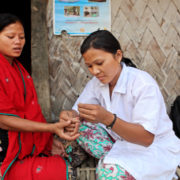Social and behavior change considerations for areas transitioning from high and moderate to low, very low and zero malaria transmission
 A 37% reduction in malaria cases and 60% reduction in mortality due to malaria in the past 15 years have saved an estimated 6.2 million lives and increased the life expectancy among those in the World Health Organization (WHO) African Region by almost ten years. The global community has called for even greater progress among the remaining 3.2 billion people at risk of infection. To this end, the WHO Global Technical Strategy (GTS) goals include reducing malaria incidence and mortality rates by at least 90%, eliminating malaria in 35 countries, and preventing re-establishment in all malaria-free countries.
A 37% reduction in malaria cases and 60% reduction in mortality due to malaria in the past 15 years have saved an estimated 6.2 million lives and increased the life expectancy among those in the World Health Organization (WHO) African Region by almost ten years. The global community has called for even greater progress among the remaining 3.2 billion people at risk of infection. To this end, the WHO Global Technical Strategy (GTS) goals include reducing malaria incidence and mortality rates by at least 90%, eliminating malaria in 35 countries, and preventing re-establishment in all malaria-free countries.
In areas with high, moderate, low, and very low transmission alike, use and uptake of malaria interventions rely heavily on community awareness, demand, and acceptance of essential commodities and services. While the WHO has recently developed a malaria elimination framework and has a number of established policies, manuals, and recommendations, detailed guidance does not yet exist for social and behavior change (SBC) in different transmission settings. While the Roll Back Malaria Strategic Framework for Malaria Social and Behavior Change Communication provides standard approaches, best practices, and indicators, it does not do so in malaria elimination contexts. This document describes the landscape of current SBC programming in such contexts and provides a number of considerations for future inquiry and research.
This document describes ways in which program planners and implementers might tailor their efforts to specific malaria transmission strata and suggests a number of operational research questions. Three case studies exemplify considerations raised and describe the role of SBC in strengthening the fight against malaria:
- The first case study from Zambia describes a successful interpersonal communication (IPC) approach paired with community-owned surveillance.
- The second case study from the Greater Mekong sub-Region describes multi-channel, cross-border initiatives.
- The third case study from South America describes the Amazon Malaria Initiative’s regional coordination.
This landscape document is an important first step in understanding how to scale-up and maintain coverage of proven interventions in all areas and support countries to effectively transition from high or moderate to low, very low, or zero levels of malaria transmission.







Leave a Reply
Want to join the discussion?Feel free to contribute!